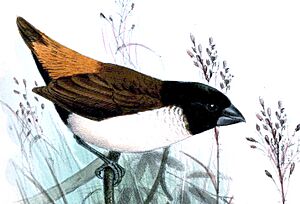Hooded mannikin facts for kids
The Hooded Mannikin (Lonchura spectabilis), also known as the New Britain Mannikin, is a small bird found on the islands of New Britain and New Guinea. It belongs to a family of birds called estrildid finches, which are often known for their colourful feathers and social behaviour.
Quick facts for kids Hooded mannikin |
|
|---|---|
 |
|
| Conservation status | |
| Scientific classification | |
| Genus: |
Lonchura
|
| Species: |
spectabilis
|
| Subspecies | |
|
|
Contents
What Does the Hooded Mannikin Look Like?
The Hooded Mannikin is a small bird. It has a whitish belly and brown feathers on its back. Its rump, which is the area above its tail, is a bright golden or orange colour. It is quite unique, so you probably won't confuse it with other birds in its home areas. Young Hooded Mannikins look a bit like young Great-billed Mannikins, but the Great-billed Mannikin is much bigger.
Different Types of Hooded Mannikins
Scientists have identified eight different forms of the Hooded Mannikin. These are called "subspecies" because they are slightly different versions of the same bird. Five of these subspecies are officially recognized. They mostly differ in the exact shades of their feathers and where they live.
For example, the New Britain mannikin has a black head and dark reddish-brown back. Its belly is creamy-white, and its rump is orange. The Mayr's hooded mannikin also has a black head, but its back is brown, and its rump is a lighter orangey-yellow. These small differences help scientists understand how the birds have adapted to different environments.
Where Do They Live?
Each type of Hooded Mannikin lives in a specific area:
- The New Britain mannikin lives on the islands of New Britain, Long Island, and Rooke Island.
- L. s. mayri is found in Irian Jaya and parts of East Sepik in Papua New Guinea.
- L. s. gajduseki lives in the eastern part of Chimbu Province.
- L. s. wahgiensis can be found in the Herzog, Saruwaged, and Bismarck Mountains.
- L. s. sepikensis lives in the Sepik plains.
- L. s. "karimui" is found in the western part of Chimbu.
- L. s. "korobae" lives near Lanke Kopiago.
- L. s. "guariae" is found in the Guari area in Central Province.
Hooded Mannikin Life and Habits
Where They Live (Habitat)
The Hooded Mannikin prefers to live in grasslands found in foothills and mid-mountain areas. They especially like areas where humans have cleared the land.
How They Behave
Hooded Mannikins are very social birds. They are often seen in groups of 30 to 40 birds. They are known for being quite brave around people. Sometimes, they can even be approached and caught by hand!
When a male and female Hooded Mannikin form a pair, they stay very close to each other. The male will often keep watch for danger while the female is busy eating or bathing. If the female flies off, the male will follow right away.
Calls and Songs
Both male and female Hooded Mannikins make a simple "peep" or "seep" sound. However, their louder calls are different. The female makes a double-noted "sileep" or "tsilip." The male makes a clear single note, "seep" or "tseep."
The male's song is a series of high-pitched "weee" notes. After several "wees," he might add up to 20 "pee" notes in a row. Males also have a softer, more complex "subsong" that they sing when they are alone or in social situations.
What They Eat
Hooded Mannikins love to eat seeds. They have been seen eating seeds from a type of grass called Rottboellia exaltata, which can be as big as rice grains. They often hang onto the stems of tall grasses to pluck the seeds directly from the plant.
Local people, like the Kalam natives, say that Hooded Mannikins also enjoy eating algae that grows on the surface of still water. People sometimes hunt them at these spots when the birds are busy feeding. The Kalam people also say that while most people eat these birds, some adults and newly married couples avoid them. This is because the birds are known to have many babies, and some couples prefer not to have a large family too quickly.
Courtship and Display
When a male Hooded Mannikin is looking for a mate, he will sing special songs to attract a female. He starts by singing with his head level, opening and closing his beak slightly.
If a female is nearby, the male might fly around with a piece of nesting material. He will then get closer to her, twisting his body towards her. He sings with his body upright, pointing his head towards her. His throat pumps, and the "weee" song becomes stronger. He puffs out the feathers on his sides and belly. In the final part of his display, he stretches his head up high, holds his beak wide open without moving it, and turns his head from side to side. He might hop closer to her, still singing a continuous, high-pitched trill, hoping she will accept him as a mate.
Reproduction and Nesting
The breeding season for Hooded Mannikins is usually in October. This is around the time when the taro plant starts to grow new shoots. A female Hooded Mannikin can lay five to six eggs.
If you find a nest with bird droppings inside, it means that a whole family of Hooded Mannikins is using it as a roosting spot at night. The local people sometimes call these nests a "Young men's house."
The nest itself is usually a flat, oval shape made from grasses, straw, and other fine plant materials. They typically build their nests in tall grasses or inside a bush. The shape and size of the nest can vary depending on where it is built, which is common for many types of munias.


